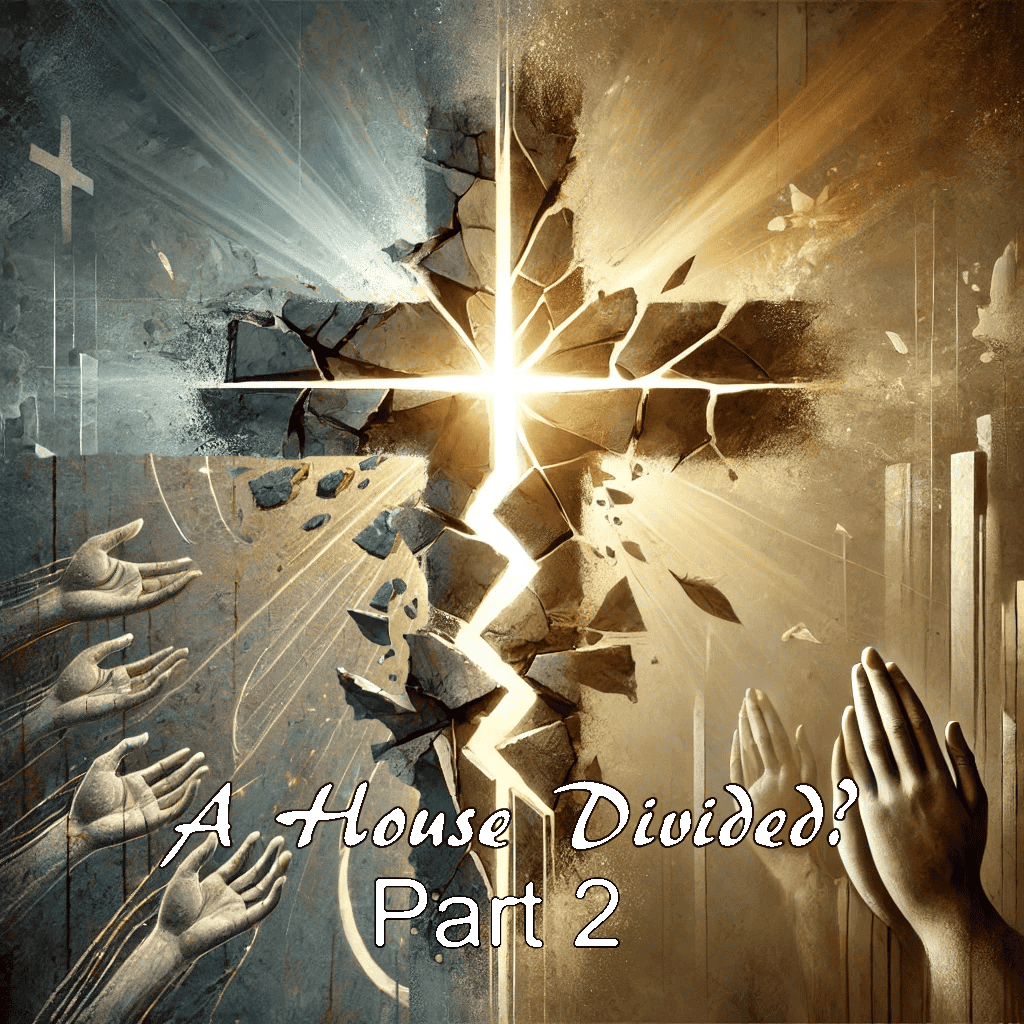Understanding the Nature of Christian Disunity
A History of Strife
The Christian Church, from its earliest days, has been shaped by moments of conflict, division, and attempts to bridge those divides. These moments have been pivotal in the development of Christianity as we know it today. If we truly seek the kind of visible unity among Christians as being the “perfectly one” envisioned in Part 1, we must first honestly confront and reconcile our differences.
Unity among Christians has faced challenges throughout history, beginning with the question over whether or not Gentile converts needed to follow Jewish law (Acts 15) and continuing toward the first major schism in 451 CE, when the Oriental Orthodox Church separated from the rest of orthodoxy following the Council of Chalcedon. These divisions persisted through the Great Schism of 1054 between Eastern and Western Christianity, the Protestant Reformation of the 16th century, and into the 20th century with Vatican II (1962-1965). This ecumenical council of the Catholic Church aimed to address modernity and foster greater unity among Christians but also provoked significant internal controversy, particularly regarding matters of worship.
Questions of heresy among believers have been the root cause of schisms. Let’s take a quick look at how heresy was understood and addressed in the early Church compared to modern times.
Heresy in the Early Church
Heresy has been a significant concern in Christianity since its earliest days, having profound impacts on the development of doctrine and church structure. In fact, it was the early Church that reframed the original Greek term, which essentially meant a “philosophical opinion,” into an “opinion that differs from established orthodoxy.” The Merriam-Webster Dictionary online defines the term as an “adherence to a religious opinion contrary to church dogma.”
In the first few centuries of Christianity, heresy posed major challenges as the Church worked to define orthodox doctrine.
The early Church referred to teachings that contradicted or distorted core Christian beliefs, particularly regarding the nature of Christ and the Trinity as heretical. A few of the key early heresies included:
- Gnosticism: Taught secret knowledge was needed for salvation and denied Christ’s humanity.
- Arianism: Claimed Christ was created and not fully divine.
- Docetism: Denied Christ’s physical body, claiming he only appeared human.
Heresies like these undermined basic theological understandings within Christian communities and threatened the unity and identity of the emerging Church. Combating them drove the development of councils, creeds, and a more structured ecclesiastical hierarchy.
Response and Consequences
The early Church responded to heresies to protect its integrity through:
- Councils that debated Christo-theological opinions and the institution of creeds to define orthodox doctrine.
- Excommunication of heretics.
- Development of a canon of scripture.
- Strengthening of episcopal authority.
Consequences for heretics could be severe, including exile or, in some cases, after Christianity became the Roman state religion, even execution. (And even those arguing against heretical positions could face punishment by heretical bishops and state leadership, as in the case of orthodox bishops who were exiled and persecuted during the Arian controversy. The most prominent example being Saint Athanasius of Alexandria, who was exiled five times during his tenure as bishop for his defense of the Nicene Creed.)
Heresy in the Modern Church
The concept of heresy and treatment of heretics have evolved significantly in modern times:
- Many churches maintain formal definitions of heresy, but there’s less consensus across denominations about which doctrines are heretical.
- Some liberal theologians argue for reinterpreting traditional doctrines, blurring the line between orthodoxy and heresy.
- Most churches no longer have legal power to punish heretics.
- Responses typically involve theological debate, censure, or excommunication rather than physical punishment.
- Some denominations are more tolerant of doctrinal diversity.
- Increased religious pluralism and secularism have changed the context for defining orthodoxy.
- The internet and social media facilitate the rapid spread of unorthodox ideas.
- Some argue that focusing on “heresy” is less relevant in addressing modern spiritual needs.
While heresy remains a concern, its ramifications are generally less severe and far-reaching than in the early Church. There is a recognition that some historical “heresies” arose from sincere attempts to understand complex doctrines and that cultural and linguistic factors have contributed to misunderstandings. Among many Christian communities, the focus has shifted more towards maintaining doctrinal integrity through religious education and debate rather than “coercive enforcement,” which in itself should allow space for charitable dialogue and a mutual recognition of a love for Jesus.
Contemporary Challenges
The Protestant ideal of Sola Scriptura, “by scripture alone,” maintains some unifying spirit among the various Protestant denominations; however, even there we find discord.
Varying views on what constitutes true biblical unity shape approaches to ecumenism and inter-denominational cooperation, contributing to the ongoing existence of numerous Christian denominations and traditions. Key factors include:
- Doctrinal differences: Disagreements over theological issues like the nature of salvation, communion, or church authority continue to divide denominations.
- Institutional structures: Unique governance models and practices in different denominations can hinder efforts to find common ground.
- Cultural expressions: Christianity’s spread across diverse cultures has led to a variety of faith expressions, including doctrinal understandings, complicating any real sense of unity.
Today, we see new sources of division, particularly over issues like gender roles, same-sex marriage, LGBTQ+ demands, as well as the ongoing abortion debates, all leading to further schisms like those recently seen in mainline Protestant denominations. Social, political, and historical contexts maintain a strong influence over religious perspectives and create barriers between Christians.
Why Disunity Persists
Despite the Spirit’s work, disunity over theological, ecclesiastical, and political issues remains a challenge. Below are some of the (obvious) reasons:
- Human Sinfulness: Even with the indwelling of the Holy Spirit, believers still struggle with narrow-mindedness, selfishness, pride, and other sins that lead to conflict and division.
- Immature Faith: Especially important these days is continued prayerful study and self-reflection. Spiritual growth is a process. “Immature” believers may lack the understanding or the willingness to embrace the full implications of unity in Christ.
- Misunderstanding of Scripture: In many cases, differing interpretations of the Bible lead to doctrinal disputes, negative feelings between denominations, and denominational splits.
- Focus on Secondary Issues: Emphasis on non-essential doctrines or practices can overshadow the core unity found in Christ.
- Lack of Love: Failure to prioritize love for one another, as Jesus commanded, leads to judgment, intolerance, and division. (A good definition of love, by the way, is “willing the good of the other as other” – Thomas Aquinas. Several denominations do not adhere to creeds, but for those of us who can at least loosely agree on the principles held by the Apostles’ Creed, can we not will the good of brothers and sisters in Christ and find some genuine Christian unity therein?)
Moving Beyond the Strife
Certainly, there are theological boundaries that, when crossed, place one outside the Christian Church. For example, the idea that the soul is an emanation from God—a concept influenced by Neoplatonic thought and introduced by some Gnostics—was met with significant controversy and opposition from early Church Fathers. While Augustine’s later writings occasionally engaged with similar themes, this idea remains disconnected from both historical Christianity and Scripture. To assert such notions as the teachings of Jesus would be a departure from the faith’s core tenets.
However, as the divisions among Orthodox, Catholic, and Protestant traditions demonstrate, there can be sincere differences in understanding within the Church. Striving for theological faithfulness while fostering a spirit of grace and community among diverse believers is a continual challenge. Interpretations of biblical unity profoundly influence modern Christian communities at institutional, local, and personal levels, and the practical outworking of this ideal remains a source of both cooperation and tension within the broader body of Christ.
Through understanding the nature of Christian disunity we might find, that in answering Jesus’ prayer, a willingness to soften the edges of some of our doctrinal certitude may be the hardest but most helpful place to be.
In Part 3 we’ll look at the sin of disunity and the ontological shift.

